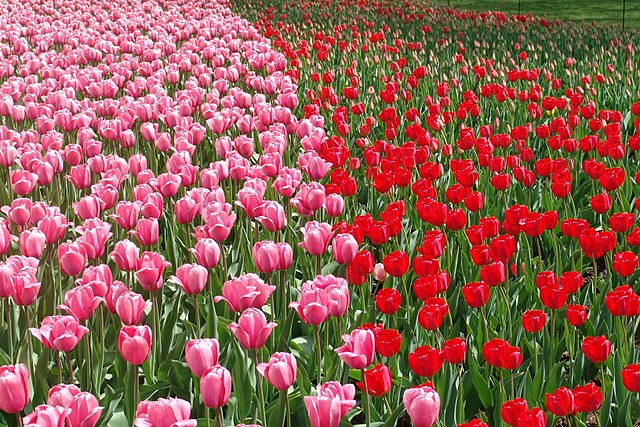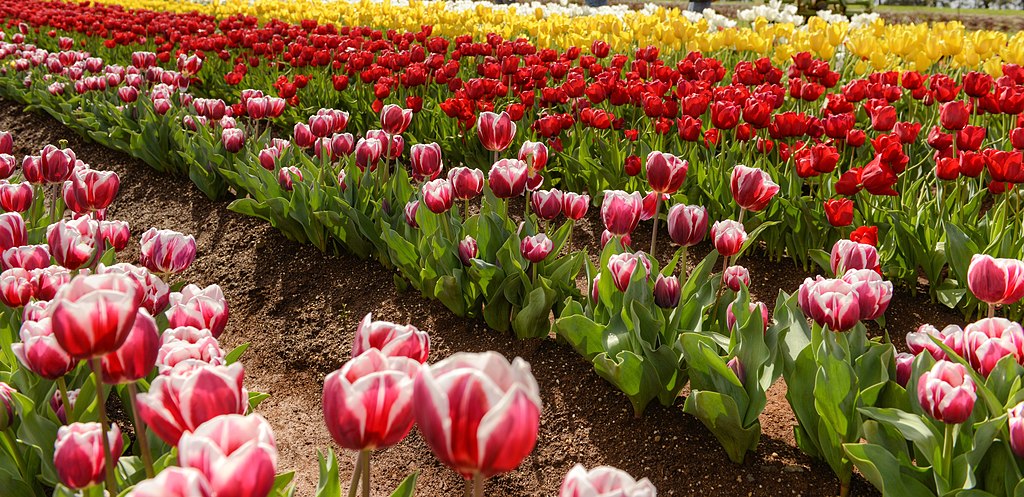
A book newly acquired by the Thammasat University library should be of interest to students in the fields of biology, plant science, economics, history, and related fields. Tulipomania: The Story of the World’s Most Coveted Flower & the Extraordinary Passions It Aroused is shelved in the General Stacks of the Pridi Banomyong Library, Tha Prachan campus.
It describes speculation on the stock market in the 1600s in tulip bulb futures trading. At the time, tulip traders were paid so much money that they earned the equivalent of almost two million baht per month. A single tulip bulb might be sold for several times what an average worker would earn in an entire year.
Tulips usually have large, showy and brightly colored red, yellow, or white flowers. The tulip is a member of the lily family, with about 75 species. The name tulip is considered by some etymologists to originate with the Persian word for turban, a type of head covering which it supposedly looked like.
Tulips originated from Southern Europe to Central Asia starting around the year 900CE, and were cultivated in Turkey. In the 1500s, the first tulip bulbs were sent to the Netherlands, where they gradually became wildly popular as a commodity traded on the first-ever futures market. This trading did not continue for long, but while it lasted, it produced many dramatic exchanges.
The TU Library owns another books about the subject, Tulipmania: Money, Honor, and Knowledge in the Dutch Golden Age by Anne Goldgar, a professor in early modern European history at King’s College London, United Kingdom.
Nowadays, the term tulip mania is used to describe any large economic bubble when prices differ from actual value.

Unusual appearance
Why were tulips considered special? They had deep colors unlike those known in Europe at the time. Tulips were considered a symbol of luxury and fine living. They were divided into classifications, according to whether they were a single color, red, yellow, or white; different colors, such as white streaks on a red or pink background; white streaks on a purple or lilac background; and yellow or white streaks on a red, brown or purple background.
The more complex the coloring, the more the flowers were valued. Tulips were considered so distinguished that growers gave them names with honorable titles such as Admiral and General, as if the flowers were distinguished military officers. The best of these were termed Admiral of Admirals and General of Generals.
In an article in Smithsonian Magazine in September 2017, Professor Anne Goldgar offered further details about the tulip mania:
According to popular legend, the tulip craze took hold of all levels of Dutch society in the 1630s. “The rage among the Dutch to possess them was so great that the ordinary industry of the country was neglected, and the population, even to its lowest dregs, embarked in the tulip trade,” wrote Scottish journalist Charles Mackay in his popular 1841 work Extraordinary Popular Delusions and the Madness of Crowds. According to this narrative, everyone from the wealthiest merchants to the poorest chimney sweeps jumped into the tulip fray, buying bulbs at high prices and selling them for even more. Companies formed just to deal with the tulip trade, which reached a fever pitch in late 1636. But by February 1637, the bottom fell out of the market. More and more people defaulted on their agreement to buy the tulips at the prices they’d promised, and the traders who had already made their payments were left in debt or bankrupted. At least that’s what has always been claimed.
In fact, “There weren’t that many people involved and the economic repercussions were pretty minor,” Goldgar says. “I couldn’t find anybody that went bankrupt. If there had been really a wholesale destruction of the economy as the myth suggests, that would’ve been a much harder thing to face.”
That’s not to say that everything about the story is wrong; merchants really did engage in a frantic tulip trade, and they paid incredibly high prices for some bulbs. And when a number of buyers announced they couldn’t pay the high price previously agreed upon, the market did fall apart and cause a small crisis—but only because it undermined social expectations.
“In this case it was very difficult to deal with the fact that almost all of your relationships are based on trust, and people said, ‘I don’t care that I said I’m going to buy this thing, I don’t want it anymore and I’m not going to pay for it.’ There was really no mechanism to make people pay because the courts were unwilling to get involved,” Goldgar says.
But the trade didn’t affect all levels of society, and it didn’t cause the collapse of industry in Amsterdam and elsewhere. As Garber, the economist, writes, “While the lack of data precludes a solid conclusion, the results of the study indicate that the bulb speculation was not obvious madness.”

Thailand and Tulips
The Siam tulip or summer tulip is a tropical plant native to Laos, northern Thailand, and Cambodia. Despite its name, it is not related to the tulip, but to different ginger species such as turmeric. It can grow as an indoor plant, and is also sold as a cut flower.
One of the most famous wild fields of Siam tulips is in Pa Hin Ngam National Park in Chaiyaphum Province.
TU students may have also heard of the Nonthaburi Tulip Garden at 49/1-2 Soi Ton Thaen (Soi Chaengwattana-Pak Kret 28) Chaengwattana Road, Pak Kret District, Nonthaburi. In 2008, U&V Inter-Trade Co., Ltd. started growing tulip flowers in Nonthaburi. The company imported 100,000 tulip sets from the Netherlands and put them in an air-conditioned greenhouse in which the temperature was controlled at 5-25˚C.
Increasing popularity in the Kingdom
In July 2017, The Nation reported that tulip farming was becoming more popular in Northern Thailand, noting:
Farmers in Northern Thailand are growing tulips as the cooler weather is suitable for the flower that thrives in temperate climate.
In June 2018, Khaosod English published an article reporting from Pa Hin Ngam National Park:
Fuschia fields of Siam tulips are standing proudly to greet visitors at a northeast national park for a short-lived summer bloom, a national park employee said Monday. Pa Hin Ngam National Park will be sprinkled with lively colors as the tropical plant – more closely related to ginger than the tulip – blossoms through early August.
“There’s quite a lot of blooms this year,” Ratchadaporn Samadee, a park employee at the park said by phone. “I recommend visitors come in the morning to see the flowers, because there’s fog among them too.”
There is also a Tulip of Siam Festival in Buriram as Thai Travel News explained in December 2016:
Play La Ploen Flora Park, approximately 32 km. from the city of Buriram in Thailand’s northeast, is one of the province’s newest tourist attractions. Opened only last year, the attraction is the perfect place for plant-lovers and their families to come and enjoy the cooler weather and long holidays. The Tulip of Siam Festival will be ongoing from now until 28th February 2017, and during this time, there will be some stunning blooms on display in the park alongside fun sculptures and examples of local culture.
Flower lovers will be particularly interested in the beautiful Strong Gold species which are among the most sought after of flowers thanks to their strong yellow colour and classic shape. As well as tulips, the flora park of Play La Ploen also boasts several other kinds of winter flowers including begonia, hydrangea, lily, cyclamen, and hollyhock among others.

(All images courtesy of Wikimedia Commons)
